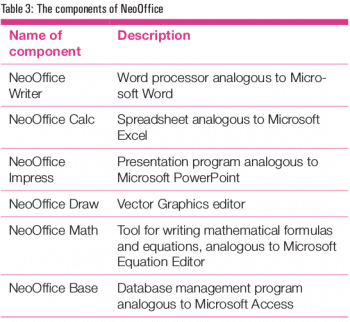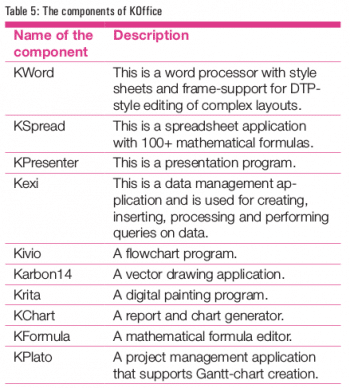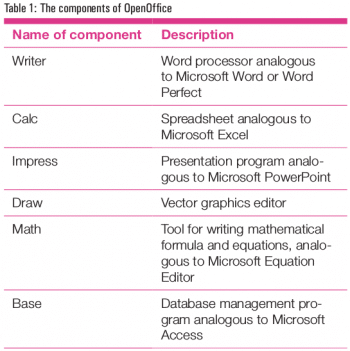Office suites have become common organisational and productivity tools. While Microsoft Office is the most popular suite today, there is a growing demand for more affordable alternatives. Numerous open source office suites have hit the market. Here is a selection of the top five Open Source Alternatives to Microsoft Office that users can explore and use.
For the past several years, Microsoft Office has remained the leader in office productivity software offering integrated applications for word processing, spreadsheets, presentations, database management, email handling and above all, desktop publishing. An office suite is a mandatory part of any operating system’s ecosystem. It is difficult to imagine a desktop operating system without office software. Windows has the Microsoft Office suite, which now dominates even the Mac market with Office for Mac. But for the Linux operating system, there are many choices available.
Some of the open source or free alternatives are even better than Microsoft Office when it comes to minimising costs and their capability to work with office files. However, all office suites are not the same and each has some limitation or the other. One also needs to bear in mind that the formatting of one file type can be saved in different ways for different programs. This can cause problems when sharing files with those using different software. Therefore, it’s important to ensure that the formatting is retained accurately. On top of that, you also need to ask which types of office software you actually need. Most packages offer documents and spreadsheets as standard, but some providers may not provide database or presentation software in a bundle. So it’s important to check what you need and evaluate this against what providers will actually supply.
Here, we’ll list the best open source office software alternatives to Microsoft Office for both home and business users.
1. OpenOffice
On July 19, 2000, at OSCON, Sun Microsystems announced it would make the source code of StarOffice available for download. The intention was to build an open source development community around the software, and provide a free and open alternative to Microsoft Office. The new project was known as OpenOffice.org and the code was released as open source on October 13, 2000. OpenOffice.org became the standard office suite on Linux and spawned many derivative versions. It quickly became a competitor to Microsoft Office, achieving 14 per cent penetration in the large enterprise market by 2004. The development of OpenOffice.org was sponsored primarily by Sun Microsystems, which used the code as the basis for subsequent versions of StarOffice.
After acquiring Sun in January 2010, Oracle Corporation continued developing OpenOffice.org and StarOffice, which it renamed Oracle Open Office. In June 2011, Oracle contributed the trademarks of this software to the Apache Software Foundation. It also contributed Oracle-owned code to Apache for relicensing under the Apache License, at the suggestion of IBM, as the latter did not want the code put under a copyleft licence. This code drop formed the basis for the Apache OpenOffice project.
OpenOffice.org (OOo), commonly known as OpenOffice, includes a word processor (Writer), a spreadsheet (Calc), a presentation application (Impress), a drawing application (Draw), a formula editor (Math) and a database management application (Base). Its default file format is the Open Document Format (ODF), an ISO/IEC standard, which originated with OpenOffice.org. It can also read a wide variety of other file formats, particularly those from Microsoft Office. Apache renamed the software Apache OpenOffice.
OpenOffice.org was primarily developed for Linux, Microsoft Windows and Solaris, and later for OS X, with ports to other operating systems. It is distributed under the GNU Lesser General Public License version 3 (LGPL).
Latest Version: 4.1.14
Website: www.openoffice.org
2. LibreOffice
On September 28, 2010, it was announced that The Document Foundation would be the host of LibreOffice, a new derivative of OpenOffice.org. The Foundation’s initial announcement echoed users’ concerns that Oracle would either discontinue OpenOffice.org, or place restrictions on its use as an open source project, as it had done with Sun’s OpenSolaris. The alternative name LibreOffice was picked after researching trademark databases and social media, as well as after checking to see if it could be used for URLs in other countries too. Earlier, OpenOffice.org had been distributed as BrOffice.org in Brazil by the BrOffice Centre of Excellence for Free Software because of a trademark issue. LibreOffice 3.3 beta used the ooo-build infrastructure and the OpenOffice.org 3.3 beta code from Oracle, then adding selected patches from Go-oo. Later, Go-oo was discontinued in favour of LibreOffice.
Since the office suite that was branded OpenOffice.org in most Linux distributions was in fact Go-oo, most users moved immediately to LibreOffice. It was forked in 2010 from OpenOffice.org, and uses the international ISO/IEC standard Open Document File format (ODF) to save documents for all of its applications. LibreOffice also supports the file formats of most other major office suites, including Microsoft Office, through a variety of import/export filters.
LibreOffice is available for a variety of computing platforms, including Microsoft Windows, macOS, and Linux (including a LibreOffice Viewer for Android). The LibreOffice project uses a dual LGPLv3 (or later) / MPL 2.0 licence for new contributions in order to allow the licence to be upgraded. Since the core of the OpenOffice.org codebase was donated to the Apache Software Foundation, there is an ongoing effort to get all the code rebased to ease future licence updates.
LibreOffice supports third-party extensions. It lists more than 320 extensions and scripts for LibreOffice, which can be written in C++, Java, CLI, Python, and LibreOffice Basic. LibreOffice Basic is a programming language similar to Microsoft Visual Basic for Applications (VBA) and is available in Writer, Calc and Base. It is used to write small programs known as macros, with each macro performing a different task, such as counting the words in a paragraph.
LibreOffice has the same six applications as Apache OpenOffice—Writer, Calc, Impress, Draw, Base and Math—but the two suites differ in terms of the applications’ features, usability and community support. Specifically, LibreOffice is often considered to be more actively developed than OpenOffice; the standard package, for example, offers PDF import, a presentation minimiser and a Wiki publisher. Users can expand functionality with extensions and templates as well.
LibreOffice Portable is a full-featured portable version of LibreOffice for Windows. It includes a word processor, spreadsheet, presentation tool, drawing package and database. It is packaged as a portable app, so you can take all your documents and everything you need to work with them, wherever you go. It is packaged in the PortableApps.com format; so it can work with the PortableApps.com platform and its automatic updater and app store, as well as with other portable menus. It can also work by itself from a USB, the cloud or local drive.
Website: www.libreoffice.org
3. NeoOffice – An office suite for Mac
NeoOffice was the first OpenOffice.org fork to offer a native Mac OS X experience, with easier installation, better integration into the Mac OS X interface, and use of Mac OS X’s fonts and printing services without additional configuration and integration with the Mac OS X clipboard and drag-and-drop functions.
NeoOffice began as a project to investigate methods of creating a native port of OpenOffice.org to Mac OS X. The project, now called NeoOffice, was originally dubbed NeoOffice/J, reflecting its use of Mac OS X’s Java integration to enable a native application. A related project was NeoOffice/C, which was a simultaneous effort to develop a version using Apple’s Cocoa APIs. But NeoOffice/C proved very difficult to implement and was highly unstable, so the project was set aside in favour of the more promising NeoOffice/J. All versions from NeoOffice 3.1.1 to NeoOffice 2015 were based on OpenOffice.org 3.1.1. In 2013, NeoOffice moved to a commercial distribution model via the Mac App Store. The source code is still available for free, but the software package is only available with the purchase of a commercial licence.
NeoOffice’s most basic version is free and is capable of viewing and printing PDF files as well as exporting other documents into the format. It is a commercial fork of the free/open source OpenOffice.org that implements most of the latter’s features, including a word processor, spreadsheet, presentation program, and graphics program, and adds some features not present in the MacOS versions of LibreOffice and Apache OpenOffice.
 Latest version: 2017.20
Latest version: 2017.20
Website: www.neooffice.org
4. OnlyOffice
In 2009, a group of software developers, headed by Lev Bannov, launched a project called TeamLab, a platform for internal team collaboration. In March 2012, TeamLab introduced the first HTML5 based document editors at CeBit. In July 2014, Teamlab Office was officially rebranded to OnlyOffice and the source code for the product was published on Sourceforge and GitHub. In February 2017, the app for integration with ownCloud/Nextcloud was launched. In February 2018, OnlyOffice desktop editors became available as a snap package. In January 2019, OnlyOffice announced the release of end-to-end encryption functionality.
OnlyOffice is an open source office suite developed by Ascensio System SIA. It is delivered either as a SaaS solution or as an installation for deployment on a private network. Access to the system is through a private online portal. OnlyOffice is divided into several modules: Documents, CRM, Projects, Mail, Community, Calendar and Talk.
OnlyOffice includes an online editing suite. It combines text, spreadsheet and presentation editors that include features similar to Microsoft desktop editors (Word, Excel and PowerPoint). Since version 5.0 of the editors, the interface has been renewed with a tabbed toolbar. OnlyOffice Desktop is an offline version of the OnlyOffice editing suite.
 Latest version: 10.0.1
Latest version: 10.0.1
Website: www.onlyoffice.com
5. KOffice
In 1997, Reginald Stadlbauer first developed KPresenter, and this was followed by KWord, in 1998. The first official release of the KOffice suite was on October 23, 2000, when it was launched as part of the K Desktop Environment 2.0. KOffice underwent a major transition as part of the release of KDE Software Compilation 4 (SC4). The KOffice team prepared a major new release – KOffice 2.0 – which used the new KDE Platform 4 libraries. Although version 2.0 was released in 2009, this was labelled a ‘platform release’.
In May 2010, version 2.2.0 was released, with an unprecedented number of new features and bug fixes. In mid-2010, the KOffice community split into two separate communities, KOffice and Calligra. KOffice forked the KSpread spreadsheet utility to KCells, the KPresenter presentation tool to KOffice Showcase and the Karbon14 drawing tool to KOffice Artwork. KOffice 2.3 was released on December 31, 2010. Beginning with KOffice 2.4, the developers aimed to release new KOffice versions every six months in sync with SC4 releases.
KOffice is a free and open source office suite. It contains a word processor (KWord), a spreadsheet (KSpread), a presentation program (KPresenter), and a number of other components that have varied over the course of its development history.
 Latest version: 2.3.3
Latest version: 2.3.3
Website: www.calligra.org











































































